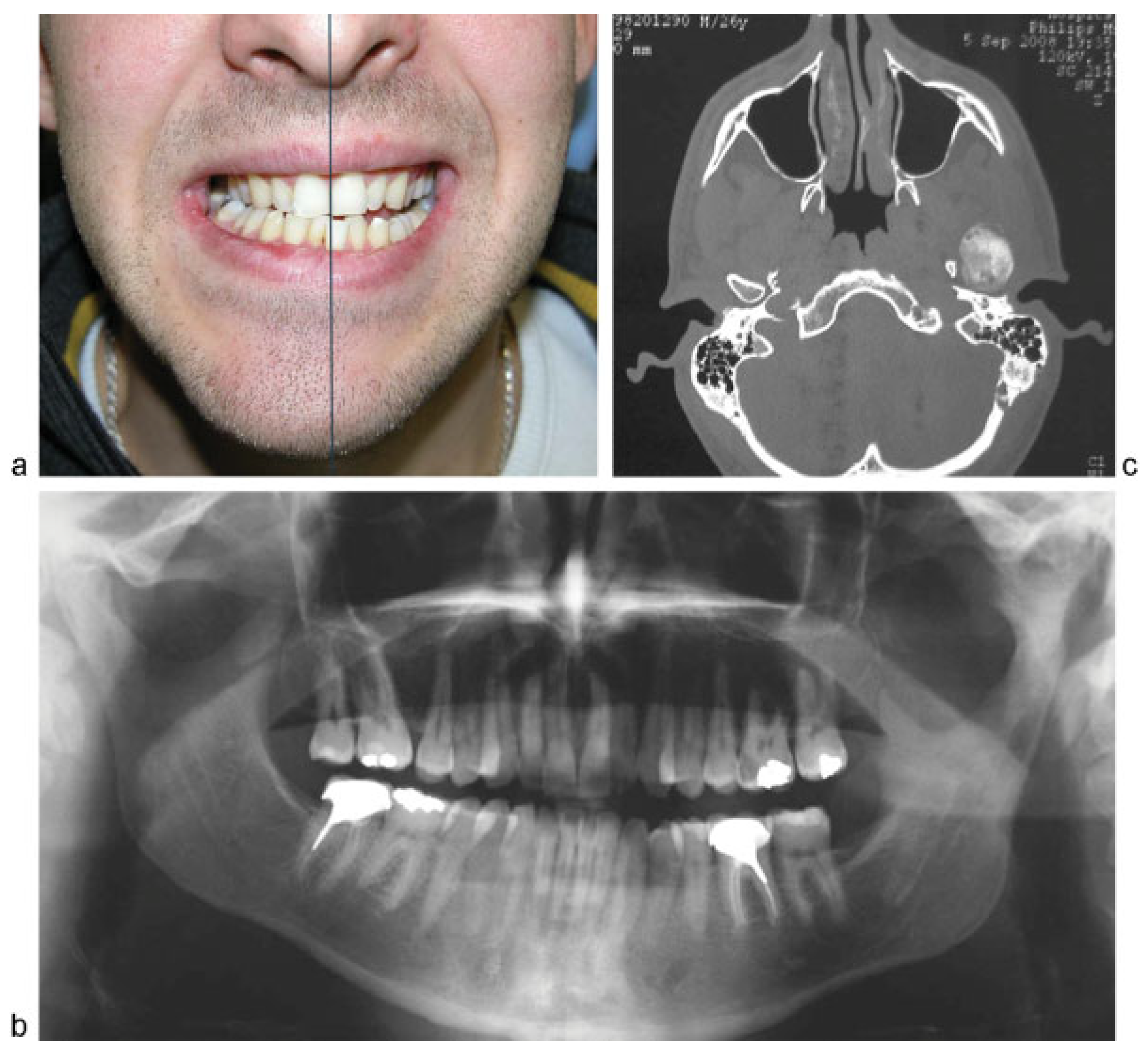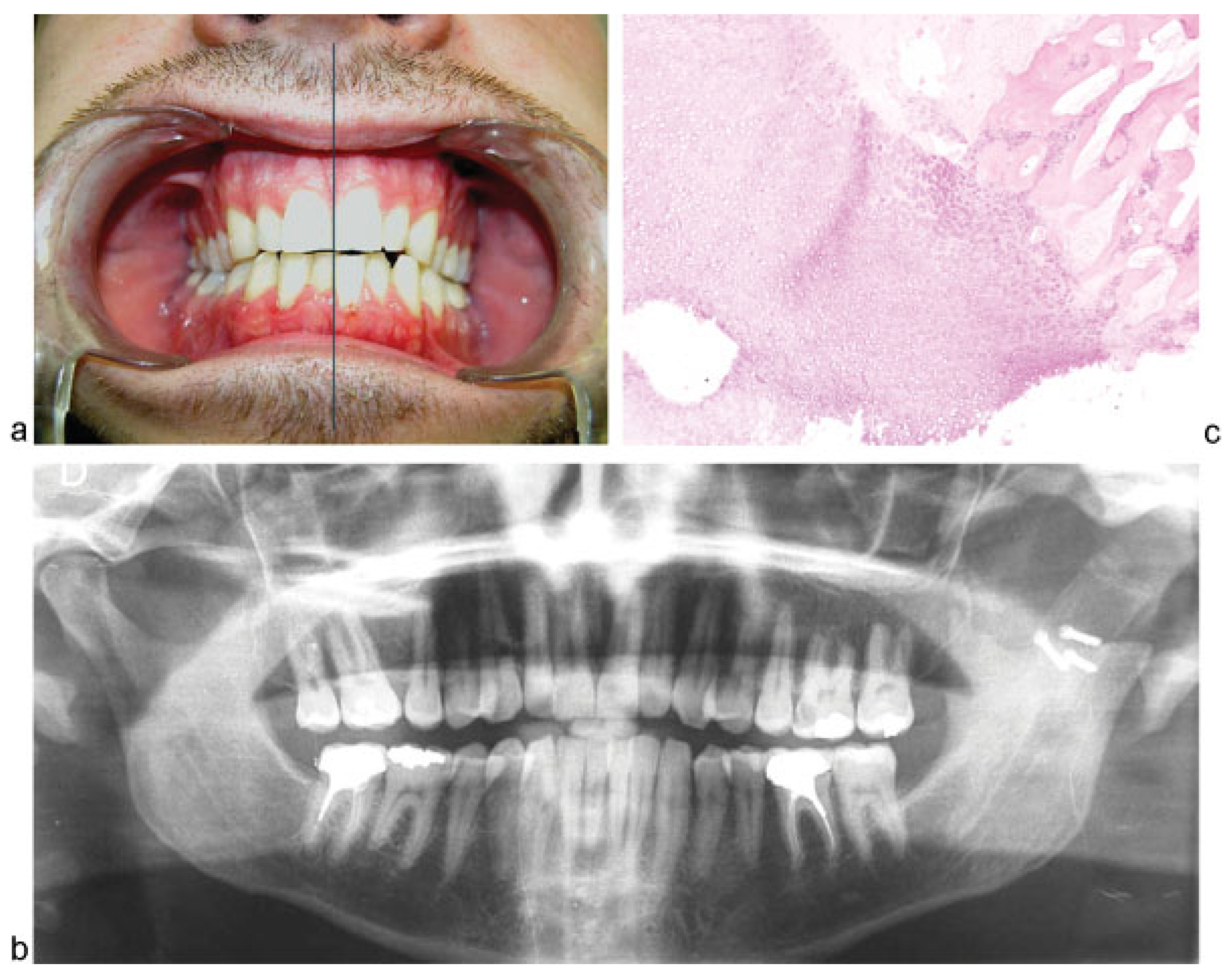Condylar Osteochondroma Treated with Total Condylectomy and Preservation of the Articular Disc: A Case Report
Abstract
Case Report
Discussion
Conflicts of Interest
References
- Aydin, M.A.; Küçükçelebi, A.; Sayilkan, S.; Celebioğlu, S. Osteochondroma of the mandibular condyle: Report of 2 cases treated with conservative surgery. J Oral Maxillofac Surg 2001, 59, 1082–1089. [Google Scholar] [PubMed]
- Karras, S.C.; Wolford, L.M.; Cottrell, D.A. Concurrent osteochondroma of the mandibular condyle and ipsilateral cranial base resulting in temperomandibular joint ankylosis: Report of a case and review of the literature. J Oral Maxillofac Surg 1996, 54, 640–646. [Google Scholar] [PubMed]
- Peroz, I.; Scholman, H.J.; Hell, B. Osteochondroma of the mandibular condyle: A case report. Int J Oral Maxillofac Surg 2002, 31, 455–456. [Google Scholar] [PubMed]
- Seki, H.; Fukuda, M.; Takahashi, T.; Iino, M. Condylar osteochondroma with complete hearing loss: Report of a case. J Oral Maxillofac Surg 2003, 61, 131–133. [Google Scholar] [PubMed]
- Wolford, L.M.; Mehra, P.; Franco, P. Use of conservative condylectomy for treatment of osteochondroma of the mandibular condyle. J Oral Maxillofac Surg 2002, 60, 262–268. [Google Scholar] [CrossRef] [PubMed]
- Roychoudhury, A.; Bhatt, K.; Yadav, R.; Bhutia, O.; Roychoudhury, S. Review of osteochondroma of mandibular condyle and report of a case series. J Oral Maxillofac Surg 2011, 69, 2815–2823. [Google Scholar] [CrossRef] [PubMed]
- Iizuka, T.; Schroth, G.; Laeng, R.H.; Lädrach, K. Osteochondroma of the mandibular condyle: Report of a case. J Oral Maxillofac Surg 1996, 54, 495–501. [Google Scholar] [CrossRef] [PubMed]
- Kurita, K.; Ogi, N.; Echiverre, N.V.; Yoshida, K. Osteochondroma of the mandibular condyle. A case report. Int J Oral Maxillofac Surg 1999, 28, 380–382. [Google Scholar] [CrossRef] [PubMed]
- Cutilli, B.J.; Quinn, P.D. Traumatically induced peripheral osteoma. Report of a case. Oral Surg Oral Med Oral Pathol 1992, 73, 667–669. [Google Scholar] [CrossRef] [PubMed]
- Ortakoglu, K.; Akcam, T.; Sencimen, M.; Karakoc, O.; Ozyigit, H.A.; Bengi, O. Osteochondroma of the mandible causing severe facial asymme-try: A case report. Oral Surg Oral Med Oral Pathol Oral Radiol Endod 2007, 103, e21–e28. [Google Scholar] [PubMed]
- Holmlund, A.B.; Gynther, G.W.; Reinholt, F.P. Surgical treatment of osteochondroma of the mandibular condyle in the adult. A 5-year follow-up. Int J Oral Maxillofac Surg 2004, 33, 549–553. [Google Scholar] [PubMed]
- Meng, Q.; Chen, S.; Long, X.; Cheng, Y.; Deng, M.; Cai, H. The clinical and radiographic characteristics of condylar osteochondroma. Oral Surg Oral Med Oral Pathol Oral Radiol 2012, 114, e66–e74. [Google Scholar] [CrossRef] [PubMed]
- Barrett, A.W.; Hopper, C.; Speight, P.M. Oral presentation of secondary chondrosarcoma arising in osteochondroma of the nasal septum. Int J Oral Maxillofac Surg 1996, 25, 119–121. [Google Scholar] [PubMed]
- Loftus, M.J.; Bennett, J.A.; Fantasia, J.E. Osteochondroma of the mandibular condyles. Report of three cases and review of the literature. Oral Surg Oral Med Oral Pathol 1986, 61, 221–226. [Google Scholar] [CrossRef] [PubMed]
- Martínez-Lage, J.L.; González, J.; Pineda, A.; Álvarez, I. Condylar reconstruction by oblique sliding vertical-ramus osteotomy. J Craniomaxillofac Surg 2004, 32, 155–160. [Google Scholar] [CrossRef] [PubMed]
- Vasconcelos, B.C.; Porto, G.G.; Bessa-Nogueira, R.V.; Nascimento, M.M. Surgical treatment of temporomandibular joint ankylosis: Followup of 15 cases and literature review. Med Oral Patol Oral Cir Bucal 2009, 14, E34–E38. [Google Scholar] [CrossRef] [PubMed][Green Version]
- MacIntosh, R.B. The use of autogenous tissues for temporomandibular joint reconstruction. J Oral Maxillofac Surg 2000, 58, 63–69. [Google Scholar] [CrossRef]
- Kaban, L.B.; Perrott, D.H.; Fisher, K. A protocol for management of temporomandibular joint ankylosis. J Oral Maxillofac Surg 1990, 48, 1145–1151, discussion 1152. [Google Scholar] [PubMed]
- Ohara, K.; Nakamura, K.; Ohta, E. Chest wall deformities and thoracic scoliosis after costal cartilage graft harvesting. Plast Reconstr Surg 1997, 99, 1030–1036. [Google Scholar] [PubMed]



© 2014 by the author. The Author(s) 2014.
Share and Cite
Dominguez, M.F.; Castillo, J.L.D.; Guerra, M.M.; Sanchez, R.S.; La Plata, M.M.D. Condylar Osteochondroma Treated with Total Condylectomy and Preservation of the Articular Disc: A Case Report. Craniomaxillofac. Trauma Reconstr. 2015, 8, 136-140. https://doi.org/10.1055/s-0034-1393727
Dominguez MF, Castillo JLD, Guerra MM, Sanchez RS, La Plata MMD. Condylar Osteochondroma Treated with Total Condylectomy and Preservation of the Articular Disc: A Case Report. Craniomaxillofacial Trauma & Reconstruction. 2015; 8(2):136-140. https://doi.org/10.1055/s-0034-1393727
Chicago/Turabian StyleDominguez, Manuel Fernandez, Jose Luis Del Castillo, Mario Muñoz Guerra, Ruth Sanchez Sanchez, and Maria Mancha De La Plata. 2015. "Condylar Osteochondroma Treated with Total Condylectomy and Preservation of the Articular Disc: A Case Report" Craniomaxillofacial Trauma & Reconstruction 8, no. 2: 136-140. https://doi.org/10.1055/s-0034-1393727
APA StyleDominguez, M. F., Castillo, J. L. D., Guerra, M. M., Sanchez, R. S., & La Plata, M. M. D. (2015). Condylar Osteochondroma Treated with Total Condylectomy and Preservation of the Articular Disc: A Case Report. Craniomaxillofacial Trauma & Reconstruction, 8(2), 136-140. https://doi.org/10.1055/s-0034-1393727


